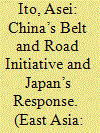| Srl | Item |
| 1 |
ID:
193777


|
|
|
|
|
| Summary/Abstract |
This study uses a text dataset of the Chinese President's speeches and reports from November 2012 to December 2021 to construct an original economic policy uncertainty (EPU) index: President Xi Jinping's EPU (XiEPU). XiEPU moderately correlates with a previous study's representative EPU, showing notably different peaks. Our index spiked in April 2016 and January 2017. Using firm-level panel data from 2012 to 2019, we find that a higher value of XiEPU is associated with a lower investment rate at the quarterly level. Moreover, there are noteworthy heterogeneous effects among firms and periods. Specifically, we find a stronger effect of XiEPU on manufacturing sectors, a weaker effect on state-owned enterprises, and a stronger effect in the second term of Xi Jinping's presidential tenure after November 2017.
|
|
|
|
|
|
|
|
|
|
|
|
|
|
|
|
| 2 |
ID:
167170


|
|
|
|
|
| Summary/Abstract |
China’s “Belt and Road Initiative (BRI)” has been gaining attention, but the evaluation of the scheme is still unsettled due to its multifaceted nature. This paper examines the basic characteristics of the initiative, disaggregates the initiative into separate dimensions, and traces Japan’s responses toward BRI from 2013 to 2018. From 2013 to 2015, the Japanese government and the Diets committee have discussed the Asian Infrastructure Investment Bank (AIIB) membership issue intensively. Only after 2015, the discussion covered the BRI, wider topics. By looking at responses by the Japanese government, the initial response until 2016 was “non-participation;” however, after 2017, the government has shifted attitude to “conditional engagement” through business cooperation in the third countries especially plus-sum dimension. Such a shift has been backed by a concurrent risk-hedging approach represented by the Indo-Pacific strategy.
|
|
|
|
|
|
|
|
|
|
|
|
|
|
|
|
| 3 |
ID:
170243


|
|
|
|
|
| Summary/Abstract |
This paper examines both the universal features and unique aspects of China’s digitalization process. The impact of digitalization, domestically and in other Asian countries, is also explored. China’s digital economy has grown rapidly since the end of the first decade of the 21st century, and compared to other countries with similar levels of economic development, China has a high rate of use of digital services. China’s digitalization process is driven by both private companies and by the state’s strategic initiatives, including social governance. China faces both opportunities and risks from digitalization. Workers in rural areas as well as older workers may face a higher risk of job loss through automation in the future. Chinese IT companies are eager to expand their activities both domestically and in foreign countries, and their investments in so-called “unicorn” companies in Southeast Asia are especially noteworthy.
|
|
|
|
|
|
|
|
|
|
|
|
|
|
|
|